Pressure gauges and switches are among the most often used instruments in a plant. But because of their great numbers, attention to maintenance--and reliability--can be compromised. As a consequence, it is not uncommon in older plants to see many gauges and switches out of service. This is unfortunate because, if a plant is operated with a failed pressure switch, the safety of the plant may be compromised. Conversely, if a plant can operate safely while a gauge is defective, it shows that the gauge was not needed in the first place. Therefore, one goal of good process instrumentation design is to install fewer but more useful and more reliable pressure gauges and switches.
One way to reduce the number of gauges in a plant is to stop installing them on the basis of habit (such as placing a pressure gauge on the discharge of every pump). Instead, review the need for each device individually. During the review one should ask: "What will I do with the reading of this gauge?" and install one only if there is a logical answer to the question. If a gauge only indicates that a pump is running, it is not needed, since one can hear and see that. If the gauge indicates the pressure (or pressure drop) in the process, that information is valuable only if one can do something about it (like cleaning a filter); otherwise it is useless. If one approaches the specification of pressure gauges with this mentality, the number of gauges used will be reduced. If a plant uses fewer, better gauges, reliability will increase.
OMEGA Engineering offers a wide range of
pressure gauges in Australia.
Pressure Gauge Designs
Two common reasons for gauge (and switch) failure are pipe vibration and water condensation, which in colder climates can freeze and damage the gauge housing. Figure 1 illustrates the design of both a traditional and a more reliable, "filled" pressure gauge. The delicate links, pivots, and pinions of a traditional gauge are sensitive to both condensation and vibration. The life of the filled gauge is longer, not only because it has fewer moving parts, but because its housing is filled with a viscous oil. This oil filling is beneficial not only because it dampens pointer vibration, but also because it leaves no room for humid ambient air to enter. As a result, water cannot condense and accumulate. Available gauge features include illuminated dials and digital readouts for better visibility, temperature compensation to correct for ambient temperature variation, differential gauges for differential pressures, and duplex gauges for dual pressure indication on the same dial. Pressure gauges are classified according to their precision, from grade 4A (permissible error of 0.1% of span) to grade D (5% error).
Protective Accessories
The most obvious gauge accessory is a shutoff valve between it and the process (Figure 5-2), which allows blocking while removing or performing maintenance. A second valve is often added for one of two reasons: draining of condensate in vapor service (such as steam), or, for higher accuracy applications, to allow calibration against an external pressure source.
Other accessories include pipe coils or siphons (Figure 5-2A), which in steam service protect the gauge from temperature damage, and snubbers or pulsation dampeners (Figure 5-2B), which can both absorb pressure shocks and average out pressure fluctuations. If freeze protection is needed, the gauge should be heated by steam or electric tracing. Chemical seals (Figure 5-2C) protect the gauge from plugging up in viscous or slurry service, and prevent corrosive, noxious or poisonous process materials from reaching the sensor. They also keep the process fluid from freezing or gelling in a dead-ended sensor cavity. The seal protects the gauge by placing a diaphragm between the process and the gauge. The cavity between the gauge and the diaphragm is filled with a stable, low thermal expansion, low viscosity and non-corrosive fluid. For high temperature applications, a sodium-potassium eutectic often is used; at ambient temperatures, a mixture of glycerine and water; and at low temperatures, ethyl alcohol, toluene, or silicon oil.
The pressure gauge can be located for better operator visibility if the chemical seal is connected to the gauge by a capillary tube. To maintain accuracy, capillary tubes should not be exposed to excessive temperatures and should not exceed 25 feet (7.5 m) in length. The chemical seal itself can be of four designs: off line, "flow-through" type self-cleaning, extended seal elements, or wafer elements that fit between flanges.
The spring rate of the diaphragm in the chemical seal can cause measurement errors when detecting low pressures (under 50 psig, 350 kPa) and in vacuum service (because gas bubbles dissolved in the filling fluid might come out of solution). For these reasons, pressure repeaters often are preferred to seals in such service. Pressure repeaters are available with 0.1% to 1% of span accuracy and with absolute pressure ranges from 0-5 mm Hg to 0-50 psia (0-0.7 to 0-350 kPa).
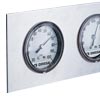 Commercial Gauges
Commercial Gauges
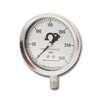 General Service Gauges
General Service Gauges
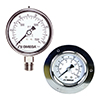 Stainless Steel Industrial Pressure Gauges
Stainless Steel Industrial Pressure Gauges
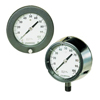 Industrial Process Gauges
Industrial Process Gauges
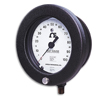 Type T: High Accuracy and Monel Wetted
Type T: High Accuracy and Monel Wetted
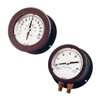 Differential Pressure Gauges
Differential Pressure Gauges
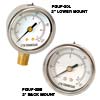 Liquid Fillable Utility Gauges
Liquid Fillable Utility Gauges
